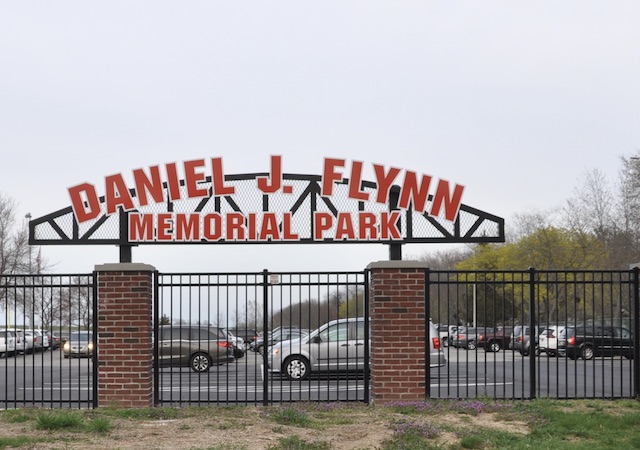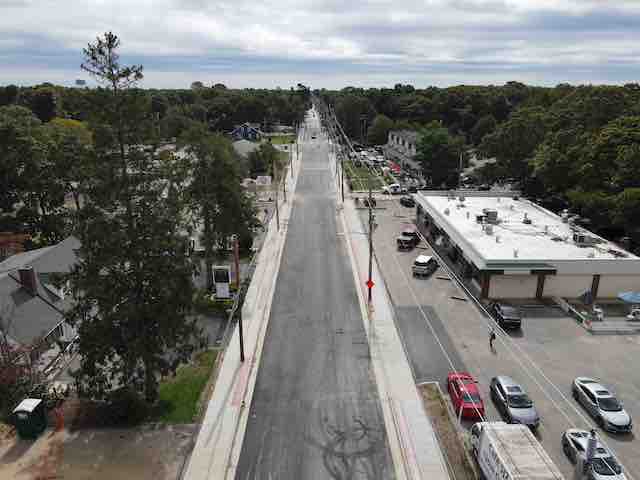News of Long Ago by Bradley Harris, Smithtown Historian
(I have been writing about the daughters of John Lawrence Smith and their descendants. Last week’s article was about Bessie Smith and her marriage to Stanford White. This article takes a further look at their marriage and traces the meteoric rise of Stanford White’s career and fame.)
“Stanford White becomes New York City’s leading architect and most famous citizen….”
When Stanford White married Bessie Smith in 1884, he was 31 and Bessie was 22. He was just getting established in his career as an architect and had only been with the firm of McKim, Meade and White for three years. But he was “earning more than $12,000 a year from the firm” and was at last financially capable of moving out of his parents’ home into his own domicile. “White was undoubtedly physically drawn to Bessie, but it is also certain that the position of the Smith family, well off, stable, with impeccable social credentials, was also in his decision to wed.” It is more likely that he was committed to her emotionally as well, and truly loved her, since he “always treated his wife with great respect, and his letters are filled with affection and concern. Typical is one written in February 1905 – scarcely a year before his death – to Bessie, who was in Italy. The four-page missive opens with ‘My darling Bess’ and closes ‘With many kisses and hugs’ and ‘lovingly,’ hardly the words of an uncaring or estranged husband.” Even so, by 1905, after 21 years of married life, there were many reasons why Bessie should have been estranged from her husband. (David Lowe, Stanford White’s New York, Doubleday, N.Y., 1992, p. 95.
When Bessie and Stanford White returned from their six month European honeymoon, they moved into a small house at 56 West 20th Street in New York City. It was here that Bessie gave birth to a boy that was named Richard Grant White in honor of Stanford’s father. When Stanford’s father died, his mother, Alexina Mease White, moved in with her son. In her memoirs, Bessie mentioned that her mother-in-law moved in with them in the small house in the city. Bessie wrote: “She was a charming, most intelligent woman and she lived with us winter and summer for 36 years until she died at the age of 88.” Even so, Bessie must have felt cramped living in the little house with her mother-in-law and a new baby. On the other hand, Bessie must have been happy for Alexina’s help with her baby. And then the little boy died “during an epidemic of so-called cholera” and that led the Whites to find another home. (Bessie Smith White’s Memories written in May of 1926, memoir on file with the Smithtown Historical Society.)
The Whites had another home “at the corner of Lexington Avenue and Twenty-first Street, on Gramercy Park” and Stanford “decorated the Gramercy Park house in a riot of imaginative details” since “he used his Gramercy Park house to charm, buffalo, wheedle and convince his clients of what they surely always thought their plans should have included.” The house at Gramercy Park became the Whites’ home in Manhattan. But after “September 26, 1887,” when “a second son, Lawrence Grant White, was born,” Bessie “spent more and more of her time” at Box Hill in St. James. “She gradually abandoned her husband’s social whirl in the city to the necessities of ‘his professional interests.’” (Michael Macdonald Mooney, Evelyn Nesbit and Stanford White, Love and Death in the Gilded Age, William Morrow and Company, Inc., New York, 1976, p.155.)
Stanford White’s professional interests continued to grow as his work became known and his reputation spread. “By the end of the nineteenth century Stanford White was New York’s most famous citizen” and “the city’s leading architect, but he was much more than that. He was the city’s leading designer, decorator, stylist and chief arbiter of taste, but he was much more than these. He was the leader of its leading artists, promoter of its best institutions, impresario of its most colorful entertainments, founder and organizer of its leading clubs, and often architect of them as well. He served as a dedicator of the city’s permanent monuments and master of ceremony of its celebrations. His immense energies were spent night and day in an attempt to give character to the city’s wealth, yet it was said of him that he never did anything for money.” (Michael Macdonald Mooney, op. cit., p. 34.)
When it came to permanent monuments and public buildings, Stanford White “designed, then donated the designs, then organized the committees to raise the funds, then supervised the construction” as he did for the Arch on Washington Square, as he did for the Madison Square Garden arena on Fifth Avenue and Broadway. “He organized, designed and built clubs in which, presumably their members might cultivate the arts of civilization: the Player’s Club, the Century, the Metropolitian, the Lambs, the Brook, the Harmonie, the Colony. The architectural firm in which he was a partner – McKim, Mead and White, designed and built dozens of others. He was a leader among his fellow clubmen.” He designed and collaborated with other artists in building churches : “the Church of the Ascension, Judson Memorial Church … and the most beautiful church, it was said, ever designed in America – Madison Square Presbyterian Church. His masterpieces would be widely imitated.” (Michael Macdonald Mooney, op. cit., p.35.)
Stanford White designed and built palaces for the city’s rich. “At incredible expense, he built and decorated palaces for the Astors and Vanderbilts; for the Goelets, the Oelrichs, the Cheneys, the Choates, the Hopkins, and the Whittemores. He gave lessons in style to Henry Villard and William C. Whitney and Whitelaw Reid. He showed his clients how to live comfortably and simply – if simplicity was their preference; or on a grand scale, either in the city, or in the country at Southampton, or in Newport.” White “was famous for his ability to spend beyond his client’s budget and then wheedle and bully for even more to build as he imagined his client ought to live. White tapped money from the rich for his city’s improvement, and his abilities at raising funds were described as ferocious.” (Michael Macdonald Mooney, op. cit., pp. 35-36.)
White’s architectural influence extended far beyond New York City. “In collaboration with artists and sculptors, White taught Chicago how it should remember Lincoln – both standing and seated; he bullied New York into learning the difference between classical ‘junk,’ and the statue of Admiral Farragut in Madison Square; at the same time, he promoted a fountain with A Boy and a Duck in Prospect Park in Brooklyn. With his partners, and with his firm’s time and expense, he helped lay out the Mall in Washington and the Lincoln Memorial. His firm rebuilt and refurbished the White House, founded the American Academy in Rome to train artists, promoted the World’s Fair in Chicago, designed libraries, improved campuses at West Point, the University of Virginia, New York University, Columbia University, and Harvard.” (Michael Macdonald Mooney, op. cit., p. 36.)
And White’s influence reached far beyond the field of architecture. “To commemorate Christopher Columbus, White organized and created a city parade. To decorate the Metropolitan Opera for an opening, he arranged twelve thousand roses. He designed magazine covers, book covers, Pullman cars, and yachts. He created pageants at Madison Square Garden to amuse the idle and he designed a perfect piece of jewelry at a moment’s notice for a soprano because, he said, she had a heavenly voice.” White worked “at a breathtaking pace,” sometimes working “straight through the night, littering the floor around his drafting table with masterpieces, bellowing melodies from Beethoven into his empty studio.” With so much creative energy coursing through his veins, “he loved, as he would any beautiful creation, pretty women.” And this love of pretty women would bring about tragic results. (Michael Macdonald Mooney, op. cit., p. 36.)
In 1887, a group of investors formed the Madison Square Garden Corporation with the stated purpose of building a new arena for the National Horse Show and boxing matches on the spot where Fifth Avenue and Broadway intersected. The Board of Directors of the new corporation “announced they would issue $1,500,000 in common stock” and chose Mr. J.P. Morgan as chairman and Stanford White as vice-chairman. It was understood that “J. P. Morgan “was clearly responsible for the Garden’s financial reputation” and “Stanford White was in charge of everything else.” The directors sponsored “a competition for the best design” of the new arena and “oddly enough the award was made to McKim, Mead and White.” The formal opening of White’s “Palace of Pleasures,” as Madison Square Garden was known, came on June 16, 1890, after the directors had spent almost 2 million dollars over the original $1,575,000 budget. “The New Madison Square Garden occupied the entire block, 465 feet long, and 200 feet wide, with side walls rising 65 feet. Its main amphitheater could seat 8,000 for the Horse Show, and as many as 17,000 for the fights. In addition, the southwest corner housed the largest restaurant in town, the northwest corner included a 1,200-seat theater, there was another street-level theater, an arcade of shops along the Madison Avenue side, an open-air theater on the Garden’s roof for light comedy in the summertime, and rising above all a Tower on the Twenty-sixth Street side, topped by a nude statue of Diana by Saint-Gaudens, 300 feet above the sidewalk.” (Michael Macdonald Mooney, op. cit., pp. 185-186.)
The tower that rose five stories above the Garden’s roof, was “thirty-eight feet square” and “contained a central elevator shaft surrounded by a spiral staircase. The elevator rose through five floors of apartments and gave access to the studio apartment on each floor. Stanford White retained the penthouse apartment in the tower for his own use and used the studio apartment for parties to entertain his most intimate friends. Many of those intimate friends were entertained by showgirls Stanford White met when they performed in musical productions that were staged during the summer in the roof-top Casino Theater at Madison Square Garden. In the summer of 1901, “the source of endless fascination, was the incredible success of a musical – Floradora. Everyone had seen it, everyone talked about it,” and “everyone followed the affairs of the beauties in the Floradora Sextette.” The Floradora Sexette were “six gorgeous,” boxum women who “paraded onstage” nightly in “frilly pink lace dresses with high collars, the dresses trimmed at their nipped waists with black velvet ribbon. They wore black gloves and big black picture hats with feathers, and each one had had a little black ribbon round her neck. Each was a picture of what a Gibson girl was supposed to be.” And it was these ladies that were capturing the hearts of men nightly as they twirled their parasols and sang their songs and delighted the crowds that came to see them. (Michael Macdonald Mooney, op. cit., pp. 22-23.)
Although the Sexette captured everyone’s attention, the musical had a supporting cast that included a young girl, “Miss Evelyn Nesbit, age sixteen,” who “had made her way from Pittsburgh, Pennsylvania, to a part as one of the ‘Spanish dancers’ in Floradora.” Evelyn “had an oval face, with a touch of olive in its color that added instead of subtracting from its baby’s milk complexion. Her nose was straight, with a little Irish upward tilt. The mouth was a bit full,” but when she pouted, “its effect could be devastating.” She was a stunningly beautiful girl whose “body was as slim as a young boy’s, with straight legs and good knees, and not even a hint of a married woman’s bottom. She knew perfectly well that voluptuous women were the current fashion, but she had already turned her lithesome form to her advantage anyway – she was a famous beauty as a model for artists and fashion photographers. Her best, she knew, was her hair – copper curls, a great mass of them, surrounding her face and creating a contrast for her hazel eyes.” This was the young beauty whose flawless features and air of innocence captured Stanford White’s attention. (Michael Macdonald Mooney, op. cit., p. 22.)
 Saturday, November 16, 2013 at 2:35AM
Saturday, November 16, 2013 at 2:35AM  Smithtown Children’s FoundationSmithtown’s civic, business and youth organizations pooled resources to deliver an enormously successful event to benefit The Smithtown Children’s Foundation, Smithtown Food Pantry and Gift of Life.
Smithtown Children’s FoundationSmithtown’s civic, business and youth organizations pooled resources to deliver an enormously successful event to benefit The Smithtown Children’s Foundation, Smithtown Food Pantry and Gift of Life.  Jason from Towers FlowersEarly bird arrivals included team Elegant Eating led by co-owners Myra Naseem and Neil Shumer to do what they do best - set up, deliver food that tastes as good as it looks and break down. Joining them was Jason from Towers Flowers of Nesconset who brought beauty to the event with fall flowers and his warm friendly smile. Representing Costco-Nesconset, Joanne Frishland and Joanne Durso were busy bees setting up refreshments and delivering baskets of goodies for raffle.
Jason from Towers FlowersEarly bird arrivals included team Elegant Eating led by co-owners Myra Naseem and Neil Shumer to do what they do best - set up, deliver food that tastes as good as it looks and break down. Joining them was Jason from Towers Flowers of Nesconset who brought beauty to the event with fall flowers and his warm friendly smile. Representing Costco-Nesconset, Joanne Frishland and Joanne Durso were busy bees setting up refreshments and delivering baskets of goodies for raffle.  Mercedes SLS 197 convertible fueled by tiny feet! To help grow those tiny feet – The Kings Park Farmer’s Market supplied a bountiful gift basket over flowing with fresh local vegetables and homemade jams.
Mercedes SLS 197 convertible fueled by tiny feet! To help grow those tiny feet – The Kings Park Farmer’s Market supplied a bountiful gift basket over flowing with fresh local vegetables and homemade jams. Smithtown Rotary sponsored Interact Club East Chamber Orchestra made an appearance and Smithtown Rotary sponsored Interact Club provided helping hands where needed. They were outstanding as was Miss
Smithtown Rotary sponsored Interact Club East Chamber Orchestra made an appearance and Smithtown Rotary sponsored Interact Club provided helping hands where needed. They were outstanding as was Miss  Miss Teen NY Nikki OrlandoTeen New York, Nikki Orlando.
Miss Teen NY Nikki OrlandoTeen New York, Nikki Orlando.  Team Moe’s Southwest Grill DECA for a fundraising event. Give General Manager, Tracey Wilgenkamp at Moe’s Southwest Grill a call for details 631-360-MOES.
Team Moe’s Southwest Grill DECA for a fundraising event. Give General Manager, Tracey Wilgenkamp at Moe’s Southwest Grill a call for details 631-360-MOES.  Edible Arrangements - Stony BrookMost colorful display goes to …Edible Arrangements of Stony Brook. While on the topic of displays… Florie’s Finales, Sweet Lucille’s, Crum Belle’s and Macayla Michaels Desserts tempted all of us into breaking our diets. They all succeeded.
Edible Arrangements - Stony BrookMost colorful display goes to …Edible Arrangements of Stony Brook. While on the topic of displays… Florie’s Finales, Sweet Lucille’s, Crum Belle’s and Macayla Michaels Desserts tempted all of us into breaking our diets. They all succeeded.  On Site Body WorksThe above represents a small bite of the people and business that participated in last night’s event. If all this seems overwhelming, guests did take a time out getting a chair massage from On Site Body Works.
On Site Body WorksThe above represents a small bite of the people and business that participated in last night’s event. If all this seems overwhelming, guests did take a time out getting a chair massage from On Site Body Works. 












